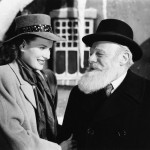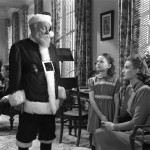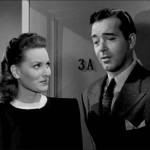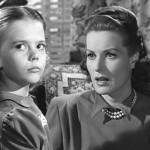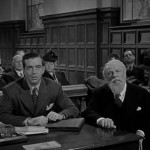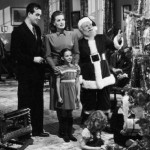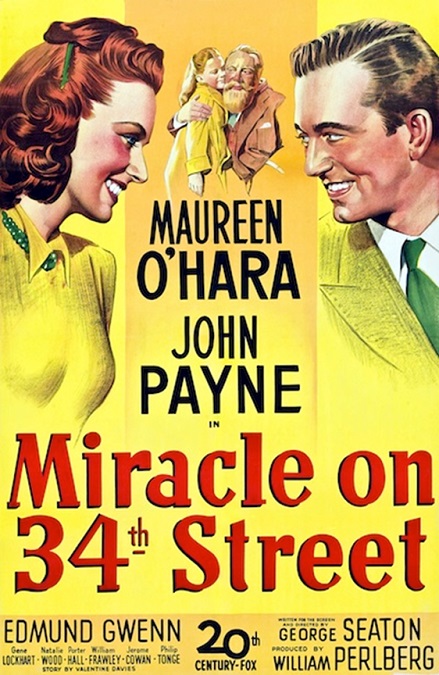
Miracle on 34th Street – 1947
Now, this was a perfect example of a Christmas movie. It was a story about whether or not Santa Clause is real. It starred Natalie Wood, Maureen O’Hara, John Payne, and Edmund Gwenn. It was a fun movie with a feel-good ending. It was also schmaltzy, and overwhelmingly sweet. Those two things are not mutually exclusive.
I’ll also say right away that the version I received from Netflix was a colorized version of the film, which is really too bad. I would rather have seen it in the original black and white. The colorization was alright, but not terribly bright. It all looked like it had a slightly gray gel over the picture, giving the whole thing a very faded look. I find that I don’t really care for colorized movies. It takes me out of the story when I can’t help noticing how much the images LOOK colorized.
The story starts with a jolly-looking old man in a suit walking down the street in New York. He stops at a store window as a man is setting up a display featuring Santa and his reindeer. The old man tells the shop owner that the flying animals are in the wrong order, implying that he believes himself to be the very man he resembles, Kris Kringle.
He is indignant when he finds a drunk man dressed as Santa, getting ready to ride on the float in the Macy’s Thanksgiving Day Parade. He talks to the parade’s director, Doris Walker, played by O’Hara, and takes the man’s place. He is a hit, and is so popular that he is given a job as Santa for Macy’s department store.
He is wonderful with the children, and has some strange ideas when it comes to promising them the toys that their parents might not be able to get. He even goes so far as to send parents to other stores if Macy’s does not have what they want.
Back at home with Doris, Natalie Wood played the part of her daughter, Susan. Doris has a policy of raising her daughter to not believe in fairy tales, fictional stories, or anything of the kind. That includes Santa Clause. Doris’s handsome young neighbor, Fred Gailey, played by Payne, is a lawyer who is trying to gain Doris’s affections by befriending Susan.
The leads were all perfectly cast. First of all, Wood was wonderful. Even as a child she was attractive, and a good actress to boot. And I’m happy to say that she did not break the cardinal sin of movie-making. She was cute, but not because she was trying to be. She just was. Her part was well written and well played. Child actors could learn a thing or two from her wonderful performance.
O’Hara was also good. She was no-nonsense, but not mean. She had a sense of humor, and a sense of frustration throughout the film that surfaced when she started getting reports that the Santa she’d hired actually believed that he was the real Santa Clause. The character was a single mother, though the film never really explained what happened to Susan’s father.
Next was Payne. The film didn’t really focus on the romance between Fred and Doris, though it certainly didn’t shy away from it either. Payne played Fred with such a likeable ease that it was easy to imagine love blooming between the two. He easily bowed to her wishes when it came to raising her daughter, but not when it came to his own principles.
But though all their performances were superb, the real stand out of the cast was Edmund Gwenn. He was instantly likeable and pleasant. He had a gentle smile that made you feel at ease. It was a smile full of generosity and light-hearted good will, just like the man in the red suit should have. And you could tell that the actor was comfortable in the role. There wasn’t a bit of angst or malice in him. Gwenn played the role to perfection.
In fact, he was so good that he won the academy award for Best Supporting Actor that year, though maybe he should have been nominated for Best Actor instead. Santa Claus was the lead in this film, not the lawyer who defended him. But John Payne was a bigger name, so they gave him top billing, even though his character was not the central character. But if that had happened, Gwenn would have been up against other leading actors like Ronald Coleman, Gregory Peck, John Garfield, and William Powell. Up against those names, he wouldn’t have won his Oscar.
This was a fun movie. There was much more to the plot, of course, mostly having to do with Kringle being put on trial for claiming to be real Santa Caluse, but it had humor and heart, and it also had a bit of brains as well. It certainly had an element of fantasy and wonder that was refreshing. There was nothing heavy, nothing really dramatic except for a few brief scenes. And the ending was one that made me smile, despite myself.

